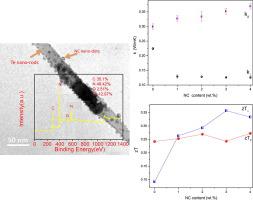Chemical Engineering Journal ( IF 15.1 ) Pub Date : 2021-03-04 , DOI: 10.1016/j.cej.2021.129212 Ahmed Gamal El-Shamy

|
Lately, thermoelectric materials have attracted attentions because they have the ability to generate electricity from a small amount of heat. Moreover, nano-composite materials based on conducting polymers are extensively applied due to their unique thermoelectric functions besides their flexibility, harmlessness, and abundance. In this regards, new nano-composite films based on Nitrogen doped Carbon nano-dots (NC) decorated Telluride (Te) nano-rods embedding into Poly(3,4-ethylene-dioxythiophene):Poly(styrenesulphonate) (PEDOT:PSS/NC@Te) have been engineered for the thermoelectric applications. The impact of NC nano-dots on the anisotropic thermoelectric functions of the PEDOT:PSS/NC@Te was briefly studied. The thermoelectric functions of PEDOT:PSS/NC@Te nano-composite films are significantly improved by the decoration of NC nano-dots on the Te surfaces. 3 wt% NC nano-dots allow the through plane electrical conductivity (165.3 ± 5 S/cm) to increase by ~ 5 times when compared with PEDOT:PSS/Te (31.9 ± 4 S/cm) due to the creation of NC@Te conductive paths inside the films and the increase in the carrier mobility. At 3 wt% NC, the through plane Seebeck coefficient (95.3 ± 3 μV/K) decreases by ~ 1.5 times lower than PEDOT:PSS/Te (146.8 ± 2 μV/K), as well as, the through plane power factor increases to be 154.6 ± 3 μV/mK2 due to the increase in both the carrier mobility and carrier concentration. Interestingly, under control through plane thermal conductivity behavior has been observed for PEDOT:PSS/NC@Te nano-composite films due to the creation of a gaseous atmosphere of nitrogen which occupies the defects and voids in the nano-composite. PEDOT:PSS/NC@Te nano-composite films exhibit a through plane figure of merit zT ~ 0.355 at a small amount of NC (3 wt%) at room temperature, which is considered one of the largest zT values as compared to their counterparts. Besides, the in plane thermoelectric functions have been briefly studied in order to introduce a full description for these thermoelectric materials.
中文翻译:

氮碳点(NC)纳米颗粒在增强PEDOT:PSS / Te纳米复合膜的热电功能中的作用
近来,由于热电材料具有从少量热量中产生电能的能力,因此备受关注。而且,基于导电聚合物的纳米复合材料由于其独特的热电功能,除了它们的柔韧性,无害性和丰度外,得到了广泛的应用。在这方面,基于氮掺杂碳纳米点(NC)的新型纳米复合膜装饰了碲化物(Te)纳米棒,并嵌入了聚(3,4-乙烯-二氧噻吩):聚(苯乙烯磺酸盐)(PEDOT:PSS / NC @ Te)专为热电应用而设计。简要研究了NC纳米点对PEDOT:PSS / NC @ Te各向异性热电功能的影响。PEDOT:PSS / NC @的热电功能通过在Te表面上装饰NC纳米点,可以显着改善Te纳米复合膜。3重量%的NC纳米点允许通过平面电导率(165.3±5 S / cm)的当与PEDOT相比,〜5倍,以增加:PSS /碲(31.9±4 S / cm)的由于创建的NC @薄膜内部的导电路径和载流子迁移率的增加。在NC含量为3 wt%时,通板塞贝克系数(95.3±3μV/ K)比PEDOT:PSS / Te(146.8±2μV/ K)降低约1.5倍,并且通板功率因数增加由于载流子迁移率和载流子浓度都增加,因此为154.6±3μV/ mK 2。有趣的是,在通过平面导热性的控制下,对于PEDOT:PSS / NC @已观察到由于形成了氮的气态气氛,该纳米复合膜占据了纳米复合材料中的缺陷和空隙。PEDOT:PSS / NC @ Te纳米复合薄膜在室温下少量NC(3 wt%)时具有贯穿平面的品质因数zT〜0.355,这是与同类产品相比最大的zT值之一。此外,已经对平面内热电功能进行了简要研究,以介绍这些热电材料的完整描述。



























 京公网安备 11010802027423号
京公网安备 11010802027423号